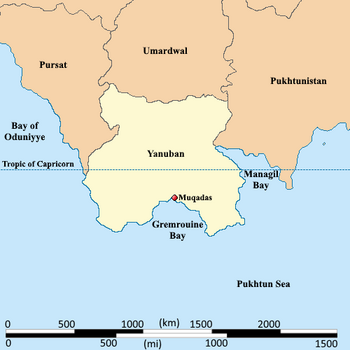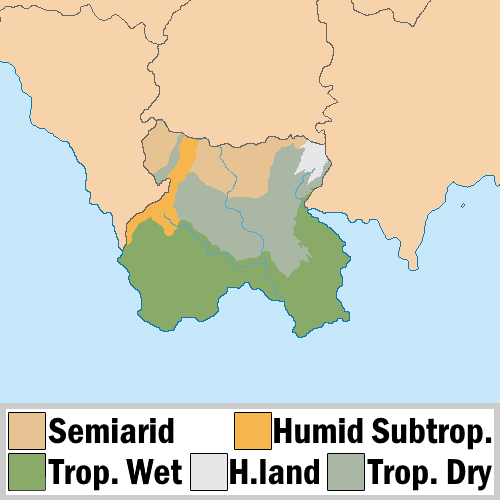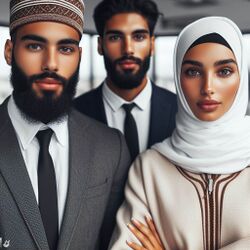Yanuban
Great Southern Republic الجمهورية الجنوبية الكبرى | |
|---|---|
|
Flag | |
 | |
| Capital and largest city | Muqadas |
| Official languages | Arabic, Burgoignesc |
| Demonym(s) | Yanubi |
| Government | Republic |
• President for Life | Simone al Zayd |
| Establishment | |
• Independence | 1836 |
| Area | |
• Total | 852,831.285 km2 (329,280.000 sq mi) |
| Population | |
• 2025 estimate | 359,955,560 |
• Density | 422.071/km2 (1,093.2/sq mi) |
| GDP (nominal) | estimate |
• Total | $5,220,075,531,120 |
• Per capita | $14,502 |
| Currency | Yanubi Dinar |
| Driving side | right side |
Yanuban, officially the Great Southern Republic, is a nation in southwestern Daria region of Audonia bordered Pursat in the west, Umardwal in the north, Pukhtunistan in the east, and the coastal confluence of the Bay of Oduniyye and the Pukhtun Sea to the south. It was massively urbanized in the 1980s and 90s and has a very high population for its landmass and is considered rapidly modernizing. Its executive is a president for life, but it does hold democratic elections for its legislative branch and local offices.
Yanuban is a member of many international organizations like the League of Nations, the ISO, Red Crescent International, etc. and many other regulatory and economic bodies.
It is a market economy focused on exports, under the watchful eye of Burgundie, whose companies have a massive stake in the country's economic activity. It specializes in the assembly of microprocessors and cellphones, as well as the cultivation of tropical hard woods, fishing, and rubber, which also constitutes its major exports.
The people of Yanuban are predominantly culturally Arab, speak Arabic, and most practice Sunni Islam.
Etymology
Yanuban means place of the south in Arabic and is named such because during the Oduniyyad Caliphate it was determined that the Tropic of Capricorn bisects the land. In Arabic the Tropic of Capricorn in the "Southern Orbit", as such Yanuban is transliterated as "the place crossed by the Southern Orbit".
Geography
Climate

Yanuban's climate is a thick belt of wet tropical climate along the southern and eastern coast. In the center of the country is a dry tropical climate. The Baqunah Mountain range in the west of the country has a humid subtropical climate. In the northern part of the country the southern reaches of the Great Kavir desert has a semi-arid climate. In the northeastern part of the country is the Mahagheh Mountains with a highland climate.
Politics and government
Yanuban is an authoritarian non-presidential republic. It is led by a President for Life, but it does hold democratic elections for its legislative branch and local offices. The judiciary is co-appointed by the President for Life and the Presidium of Muslim Clerics, a non-governmental lobbying body which provides guidance to both the President for Life and the legislature on Islamic issues and concerns with current or proposed policy. The legislature is called the People's Assembly and is a unicameral body with proportional representation from each region. The Assembly is a parliamentary system led by a Conductor-in-Chief who is elected from among their peers. The Assembly has no related restrictions, but female members are rare. An element of sheikism still remains in local politics where the richest families have outsized influence. They often provide services and decide matters of social significance outside of the government systems. In turn they are elected to local office to ensure these services continue and the weight of the law supports them.
Military
The military of Yanuban has three branches, the Army, the Aeronauticale, and the National Gendarmerie. The Army is 150,000 soldiers divided into 8 Divisions. It has a moderate armored force, comprised mostly of Kipling-era tanks, APCs, and self-propelled artillery, sold to the country by Burgundie during successive rounds of modernization. The primary firearm is the FN-FAL, also supplied by Burgundie.
The Aeronauticale is both the air force and the navy of Yanuban. It consists of 13 air wings, of which 5 are fighter/interceptors, 4 are fighter bombers, 2 are strategic airlift/logistics, and 2 are training. The naval contingent is built around 9 frigate squadrons, 5 patrol/coast guard squadrons, and a single Second Great War-era battleship, which is too expensive to put to sea, but nominally serves as the flagship and its own fleet-in-being. The Aeronauticale also serves the air-defense role and has 32 radar installations and countless anti-air batteries dotted all along its border.
The National Gendarmerie of Yanuban is the national police force of the country. It has approximately 285,400 members and is equipped and trained in the same way as the infantry in the army. Gendarmes are specially trained in riot suppression and as such also carry long batons or truncheons in addition to their FN FALS. The Gendarmerie is organized into 12 geographical police districts, whose size and staffing depends on the number of residents; as well as a Mobile Gendarmerie who have APCs and riot suppression vehicles.
Society
The culture of Yanuban is mainly the interplay of a long and deep-seated Islamification starting around 624 when its major settlements were conquered by Muslim armies. The people of modern Yanuban remained under the almost exclusive influence of the Oduniyyad Caliphate until its fall in 1517. In 1635, the Ularien Trading Company first arrived in the area and the lasting impact of Burgoignesc culture on the culture of Yanuban. Art, literature, and architecture in Yanuban are broadly within the schools and traditions of Muslim Audonia, but like many nations of the Middle seas region it is still vaguely a part of the Burgoignesc thalattocracy, as least in the cultural sense, so it draws inspiration from Occidental in general, and Burgoignesc in particular, trends and traditions. However, the influence of Burgundie on Yanubi culture was abruptly halted in 1836 and not meaningfully reintroduced until the 1960s, so Academic Art, Realism, Naturalism, Impressionism, Post Impressionism, Fauvism, Cubism, Modern art, Modernism, and Late modernism never took hold in the Yanubi art scene. A unique Post-Romanticism style emerged in the late 1800s that highlighted Islamic ideals and uniquely Audonian landscapes and motifs. This artstyle is something the Yanubi are particularly proud of and under the Zege Regime it enjoyed a renaissance often called Yanubi Neo-Post Romanticism. Likewise, the literary trends of the late 19th and early 20th century never made its way into the oeuvre of Yanubi literary practice. So, the Islamic moralist poetry remained a primary literary high point for Yanuban. In architecture, there were some minor Burgoignesc influences left over from their colonial period however, the invention of climate control and air-conditioning have had the greatest impact on traditional Yanubi architecture. While religious and government buildings still follow the precepts of Islamic architecture, most new buildings are made in a more Occidental post-industrial style. This is no doubt a result of the outsized influence Burgoignesc firms have in Yanuban.
Fashion
The Yanubi are fairly traditional in their attire. Yanubis who work in offices run by foreign companies, they will wear Occidental-styles of dress, but most Yanubis wear traditional Islamic clothing and they are rarely seen without some form of head covering. Perspectives on this are changing slowly with the advent of globalization and especially the internet, but it is still a cultural expectation that the vast majority of Yanubis are dressed more traditionally and conservatively.
Traditional attire
Traditional Yanubi attire is deeply rooted in traditional Islamic clothing, which is marked by modesty, reverence, and a sense of cultural continuity. For both men and women, these garments are not just a matter of personal choice but often a reflection of religious devotion and societal adherence. Yanubi men traditionally wear long tunics known as djellaba or thawb, paired with loose-fitting trousers. This attire is not only comfortable in the region's warm climate but also aligns with Islamic principles of modesty. The color and design of the djellaba often signify social status or regional affiliations. Women's clothing typically includes a loose, flowing garment called the abaya or jilbab, often accompanied by a headscarf or hijab. The choice of color and embellishments can vary, allowing for individual expression while still maintaining the concepts of Islamic modesty. Some women may also wear the niqab or burqa for additional coverage, this is often dictated by their family's level of fundamentalism in their interpretation of Islam. The niqab and burqa are most commonly found in the interior of th country, especially in the northern provinces on the border with Umardwal. Traditional Yanubi clothing is often adorned with intricate patterns and vibrant colors. The choice of colors and designs convey familial ties, regional affiliations, similar to the Gaelic plaids. Earthy tones and natural fabrics are commonly as a base for these designs, linen, flax, and cotton are common fabrics for garments.
Modernist fashion

In urban areas heavily influenced by Burgundie and globalized trends, there is a discernible shift in the attire of the Yanubi people. The corporate landscape, in particular, it is common for professionals to wear a fusion of Occidental and traditional Islamic styles. For men, this could mean pairing a traditional tunic with tailored trousers or a suit. Women might incorporate elements of traditional clothing, such as a hijab, while opting for professional Occidental clothing. This allows individuals to navigate the socio-religious expectations of a modern workplace while preserving cultural values. The increasing interconnectedness of the world has introduced new elements to Yanubi fashion. Global fashion trends, particularly from Occidental cultures, have increasingly commonplace in the wardrobes of many Yanubis. This is most evident in the choice of accessories, footwear, and even the occasional incorporation of Occidental-style clothing items. As a result, the youth fashion culture especially experiments with clothing styles that blend traditional and modern elements.
Cuisine
Mutton and couscous feature heavily in the Yanubi diet. Grain and rice are also common cereals. Almost all meals are a meat and vegetable as the main dish and a side of either a baguette or couscous/rice. Breakfast is light and often eaten on the go, a fairly new phenomenon, stemming from Burgoignesc influence since Operation Kipling. Lunch is taken around 11:00am, eaten slowly, and is dense and large. It is almost always eaten in a communal setting and followed by an hour rest period, where tea is consumed and men may smoke communally from a hookah/shisha. Nothing of import is discussed during this time, it is supposed to be idle banter to calm the digestion process and to not excite the body during the hottest part of the day. Dinner is eaten as a family and food is served a la table around 8:00pm.
There is a strong tea drinking culture in Yanuban. Many people will stop on their way to work to drab a quick drink, will take tea breaks throughout the day, will have tea as a digestif after lunch, and will grab a tea on the way home from work. There are tea sellers, stalls, stands, and shops everywhere, even in more rural areas. It is almost an impulse of Yanubis to stop and drink tea whenever they see it.
Coffee is becoming more popular with young Yanubis, mostly because of Burgoignesc influence. It is not widely liked by most Yanubis who find it bitter and displeasing to their stomachs, which is why they drink tea.
Alcohol is fairly common in Yanuban, but it is not imbibed in any great volume. Young men will drink a beer in the evening and young urban people will all have a drink if they go out clubbing, but more than one is considered poor taste. Drinks are often weak and sweet.
Linguistic Demographics
All Yanubis speak Arabic and those in cities and the tourist/international business sectors speak fluent Burgoignesc, around 30%. The Yanubi dialect of Arabic is mutually intelligible to most other Arabic speakers in the Middle seas region.
Religious Demographics
Yanuban is 80% Muslim, 60% of whom follow Sunni Islam, 25% are Shiite, and 15% are Sufis. Of the remaining 20%, around 9% are Jewish, 6% are Mercantile Reform Protestant, 4% are Catholic, 1% are other (Old Gods, agnostic, or irreligious).
Economy
Agriculture
In Yanuban, the agricultural sector plays a pivotal role in providing sustenance for the population and contributing to the nation's exports. The choice of crops and herd animals varies across different climatic zones, catering to both domestic consumption and international trade. Here are examples of primary food sources and key agricultural products in Yanuban:
- Wheat: Particularly in regions with a humid subtropical climate, where conditions are conducive to wheat cultivation, it serves as a staple grain for local consumption.
- Rice: In the wet tropical belt along the southern and eastern coast, rice cultivation is prominent, providing a crucial dietary staple.
- Rubber Trees: Yanuban's tropical climate makes it suitable for rubber cultivation, with rubber trees yielding latex, a valuable export commodity.
- Cotton: particularly in the semi-arid north. Cotton has long been a part of the historical trade partners of Yanuban.
- Tropical Hardwoods: The nation specializes in the cultivation and export of tropical hardwoods, contributing to the international timber market.
- Goats and Sheep: Adapted to various climatic zones, goats and sheep provide meat and wool, supporting both local diets and economic activities.
- Camels: In arid regions, camels serve as a source of meat, milk, and as pack animals, contributing to the livelihoods of local communities.
- Dates: Date palms, well-suited to arid climates, yield dates that are both consumed locally and exported, contributing to economic diversification.
Pescaculture
Yanuban's fishing industry thrives on the diverse aquatic resources of the Bay of Oduniyye and the Pukhtun Sea. The rich biodiversity in these waters provides an abundant array of fish species for both local consumption and export. The primary fish caught in Yanuban are: yellowfin and skipjack tuna, snapper, mackerel, barramundi.
Fishing Practices
- Longlining:* Yanuban's fishing vessels engage in longlining, deploying lines with numerous baited hooks to target species like tuna that are attracted to the bait.
- Trawling: Trawlers drag nets through the water to capture schools of fish, an effective method for catching mackerel and other pelagic species.
- Handline Fishing: Particularly for snapper and barramundi, handline fishing involves a single fishing line with a baited hook, providing a more artisanal and targeted approach.
- Trap and Pot Fishing: To capture crustaceans and bottom-dwelling species, traps and pots may be employed, ensuring sustainable harvesting practices.
Manufacturing
- Microprocessors and Cellphones: Yanuban's market economy, with significant influence from Burgoignesc interests, specializes in the assembly of microprocessors and cellphones for export, contributing to economic revenue.
Infrastructure
Rail
Yanuban uses Standard gauge, 1,435 mm (4 ft 8+1⁄2 in) as most of its rail infrastructure has been under the auspices of Burgundie and its sphere of influence in the Middle seas region, who all use that rail gauge.
Roads
Louage
A louage is a minibus shared taxi in many parts of Daria that were colonized by Burgundie. In Burgoignesc, the name means "rental." Departing only when filled with passengers not at specific times, they can be hired at stations. Louage ply set routes, and fares are set by the government. In contrast to other share taxis in Audonia, louage are sparsely decorated. Louages use a color-coding system to show customers what type of transport they provide and the destination of the vehicle. Louages with red lettering travel from one state to another, blue travel from city to city within a state, and yellow serves rural locales. Fares are purchased from ticket agents who walk throughout the louage stations or stands. Typical vehicles include: the MILCAR Jornalero, the TerreRaubeuer Valliant 130, and the CTC M237-07.
See also